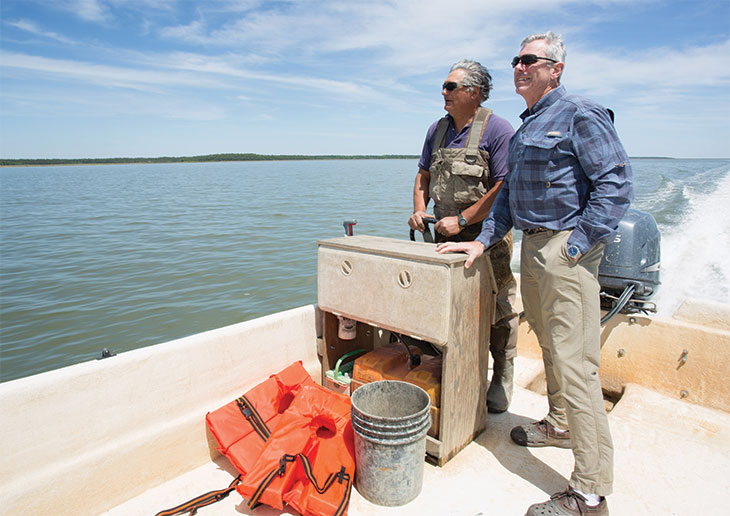
Photos by Robert Fouts
New Reef Oyster Co. general manager Steve Bessette, left, and owner John Webster speed toward Coden on the Alabama coast, where the company expects to produce 2.2 million oysters this year. The entire crop was pre-sold in early spring.
The Gulf Coast waters of Portersville Bay, Ala., are glistening on this spring morning as Dr. John Webster’s 21-foot skiff speeds away from Bayou La Batre, southwest of Mobile. In the distance, specks of lines and floating wire baskets start to bob into view.
Capt. Steve Bessette, general manager of Webster’s oyster farm, New Reef Oyster Co., slows the skiff to a putter as it approaches a boat where two employees are methodically working their way along rows of bobbing oyster baskets.
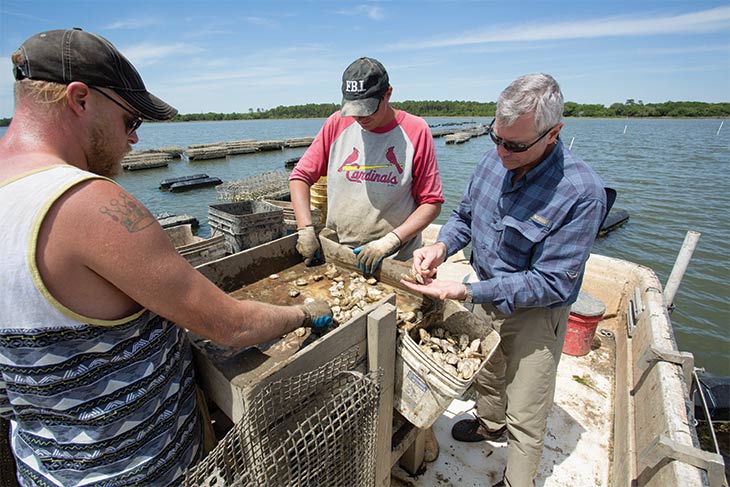
Dr. John Webster, above right, checks the quality of his farm-raised oysters, while employees sort them by size.
With well-practiced moves, the workers lift the heavy mesh baskets into their skiff and count and sort the oysters in each, separating those that are ready for market and returning the remaining oysters to the shallow waters to live another day.
But those baskets hold more than the next crop of Alabama oysters. Oyster farming, as it is known, is improving the local economy and the estuary upon which it depends.
Testing the Water
Webster first became intrigued with oyster farming six years ago, when Auburn University launched a pilot project that leased 2-acre start-up tracts in the bay to fledgling producers and showed them how to raise oysters.
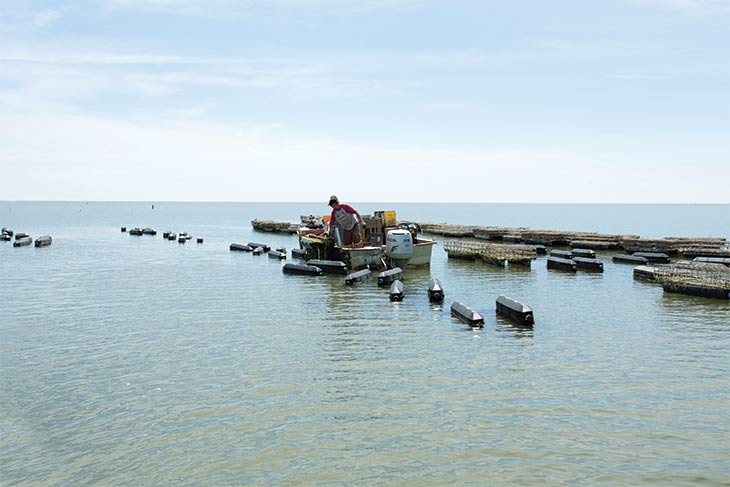
Oysters raised in floating baskets, a practice known as off-bottom farming, are protected from most predators and have a higher survival rate than bottom-raised oysters.
An army veteran and pathologist who practices in Pascagoula and Ocean Springs, Miss., he was among a handful of farmers who took advantage of the Auburn program until it ended after five years. By then, Webster was convinced of the opportunity presented by Alabama oyster farming and had fortuitously learned of a 730-foot waterfront tract for sale, with riparian rights extending out 1,800 feet.
“When Auburn lost their lease down here and I learned of this opportunity, the next conversation I had was with Alabama Ag Credit,” says Webster, who previously financed a timber tract and later a cattle tract in Monroe County with Loan Officer Michael Williams. “Alabama Ag Credit’s agricultural lending expertise has helped me move our oyster farm to a site where we can develop a successful operation for the long term. I couldn’t have done it without them.”
This portion of the riparian rights that is usable for oyster farming is 20 acres. It was important to Webster to continue building the cooperative support system that he and other early-stage farmers had benefited from. So rather than farm the entire tract himself, he opted to lease 4 acres to two other farmers and lease 2 acres to Auburn for ongoing research and education. On the remaining 14 acres that New Reef Oyster Co. currently operates, he expects to produce 2.2 million oysters this year, and 4 million oysters in 2019 — barring any risks that could befall the crops.
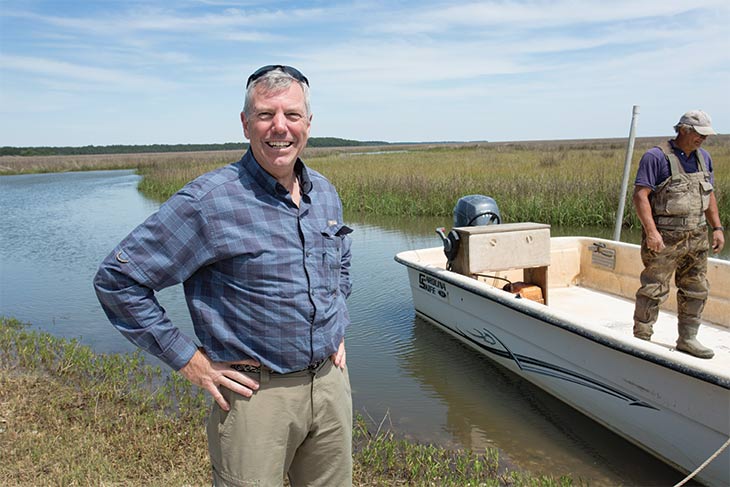
Alabama Ag Credit customer John Webster, one of 13 commercial oyster farmers in the state.
Although the hurricanes of the 2017 season had minimal impact, Alabama oyster farmers have fought hurricanes; tropical storms; water temperature variations that inhibit plankton growth, the oysters’ main food source; long periods of excessive rains, which drive the salinity down and cause pre-emptive closures; and turbidity, which is water cloudiness caused by dense particles.
“We lost a little over half the inventory one year, and another year I had 600 cages all busting at the seams that I couldn’t sell due to a very prolonged closure,” Webster says. “Just last night, the river upstream went over by 8 feet, and we were shut down.”
“Alabama Ag Credit’s agricultural lending expertise has helped me move our oyster farm to a site where we can develop a successful operation for the long term. I couldn’t have done it without them.”
–Dr. John Webster
Before any growers can reopen and harvest oysters after a shutdown like that, the state health department must first test the waters for safety. Because of health concerns, traceability of oysters is taken seriously by farmers and public health officials. Each harvest bag is tagged with its harvest date and source. Farmers may sell only to licensed distributors, who in turn market the premium, precisely sized 2.5- to 3-inch oysters to upscale raw oyster bars and restaurants. Those larger than 3 inches become “cooking oysters.”
Where to Find Mon Louis Oysters
- DumbWaiter, Mobile, Ala. — dumbwaiterrestaurant.com
- Food Bar, Birmingham, Ala.— foodbarbham.com
- Kimball House, Atlanta, Ga. — kimball-house.com
- White Pillars, Biloxi, Miss. — biloxiwhitepillars.com
Spawning a Growing Industry
Historically, Alabama has been one of the largest oyster processors in the country. Only in the past decade has Alabama evolved from the traditional practice of harvesting wild oysters with tongs to farming oysters in cages. In fact, Alabama’s first commercial oyster farm was only established in 2009.
Today, Alabama has 13 commercial oyster farms with about 25 acres in production, according to Auburn University. Those farms employ one of three farming methods:
- On-bottom farming keeps the oysters submerged at all times along the seafloor.
- Off-bottom farming uses floating mesh baskets or baskets attached to long lines.
- Off-pier farming enables individuals to raise oyster gardens from an existing pier.
Oysters spawn from late spring through late summer, during which time farmers purchase seed stock from a nursery. Oyster seed that is ¼-inch in diameter is received in sacks of 30,000.
Until this year, seed stock was available only through the Auburn University Shellfish Laboratory on nearby Dauphin Island.
“Last year, we did 18 spawns, and by Labor Day, we quit spawning,” says Dr. Bill Walton, Auburn associate professor, senior marine scientist and Extension specialist. But as the number of growers has expanded, the need for more seed stock has created new business opportunities for local entrepreneurs. With Auburn’s start-up support, two commercial hatcheries are now operating in the region.
As one of the largest oyster producers in the state, New Reef purchased 2.2 million seed last year and will purchase 4 million this season. Those youngsters will grow about ¼-inch per month until they reach market size in about a year. The 36-by-54-inch floating cages initially can hold as many as 90,000 seedling oysters, but the seed is split multiple times until there are about 1,000 mature oysters in each cage.
“Once the seed goes to the farmers, it’s up to them as to the type of husbandry and gear they use,” says Walton. “John is one extreme, with boats and hands-on labor. On the other extreme is another farmer who has gone to a highly automated system, with optical graders to sort and divide the oysters by size.”
Webster opted for the floating cages because they perform well in variable depths of water, and enable a higher density per acre of production than the Australian long-line system used by his neighboring farmers.
“The floating gear can expand out to deeper water, which will allow John to utilize the entire lease,” says Walton.
Benefits of Oyster Farming
- Does not depend on natural reef, nor does it negatively impact the local reef, which has deteriorated in recent decades
- Yields high-quality oysters that can be harvested according to size
- Helps improve water quality in the estuaries of the Gulf Coast bays, where freshwater and saltwater mix
- Creates jobs and contributes to the economy, from the boating trade to the restaurant sector
Bringing Oysters to Market
Mondays and Wednesdays are designated harvest days, consumed with sending oyster orders to distributors.
To set his product apart, Webster brands his oysters Mon Louis Oysters, named after the nearby Mon Louis Island.
“The Mon Louis is a 2.5- to 3-inch oyster, which is the optimum size for high-end raw bars and white-tablecloth restaurants,” he says.
“I have adopted the Toyota business model — high quality, low cost,” says Webster.
Admittedly, selling a crop of 2 million oysters this season was worrisome initially — until he received an order in early spring for the entire crop.
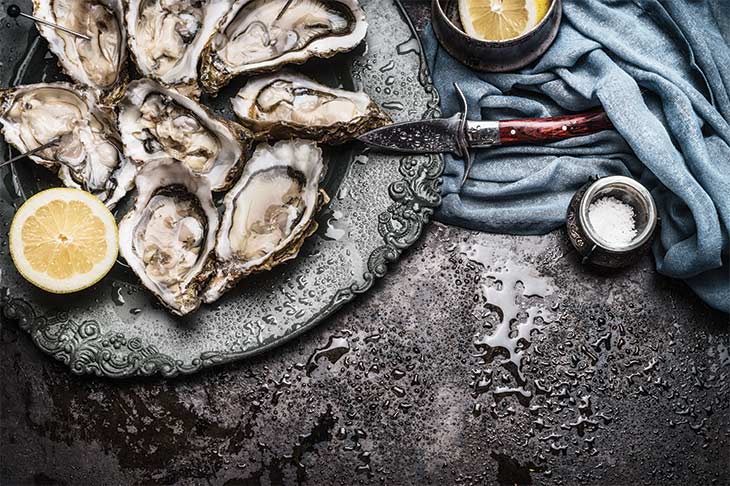
Photo by Vicuschka/Shutterstock.com
Farm-raised Gulf oysters can earn a premium on the retail half-shell market.
“John is essentially a microbrewer of oysters,” says Walton. “There are people still tonging oysters on a reef, and those oysters will all go to the shucking house. But where you will make a living is in the half-shell oyster business.”
For Webster, New Reef Oyster Co. is about a lot more than simply selling high-quality oysters. The opportunity to improve the environment and the economy is also important to him.
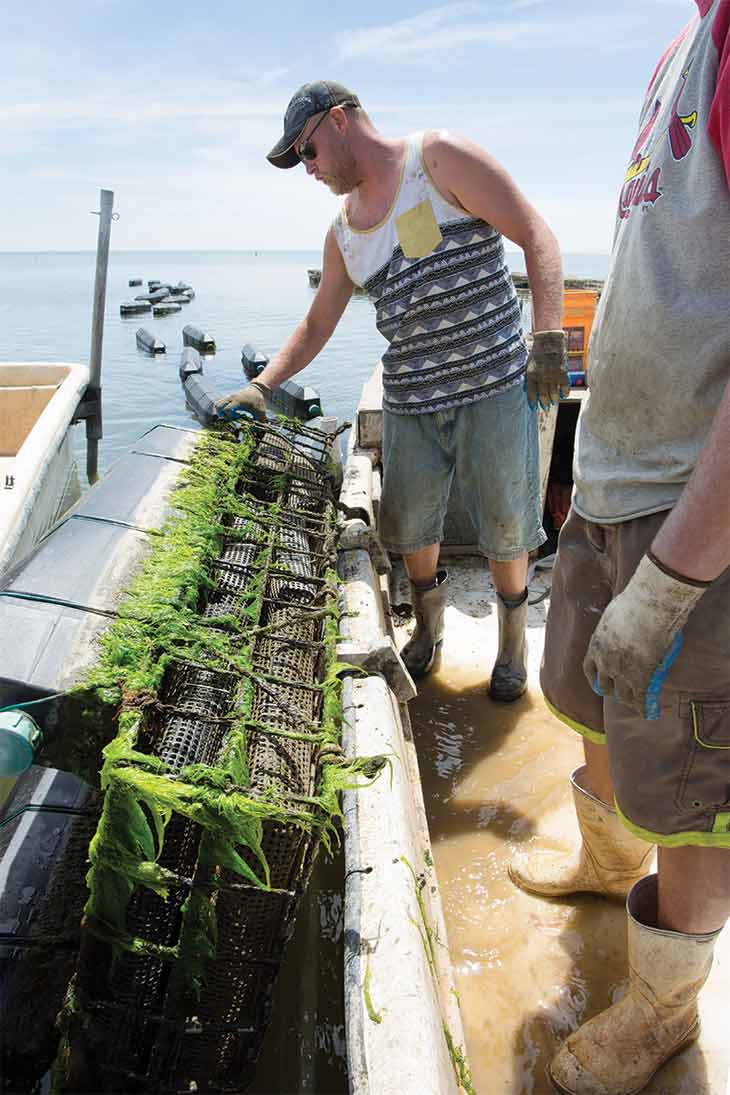
A mesh oyster basket is lifted into a skiff, where the oysters will be dumped and sorted. The baskets will be flipped and air-dried to prevent fouling, which is caused by algae, barnacles and marine organisms.
Good for the Estuary
Oysters feed on excess plankton and filter the water, keeping it clean for underwater grasses and other aquatic life. In fact, one oyster can filter more than 50 gallons of water in a day.
“Within this 24 acres of upland and 20 acres of usable riparian rights, we have three small ecosystems — longleaf pine savannah, salt marsh, and then a marine habitat where the first 300 to 400 feet from the salt marsh out that’s too shallow to work is living shoreline and the rest is oyster farm,” he says. “That is savannah grass, marsh grass and sea grass. Sea grass is probably as valuable as oyster reef to the estuary.”
At the front of the upland property, Webster has planted 200 longleaf pine seedlings, using concentrated high-impact practices to minimize the human footprint on natural habitat.
Before oyster farming began its new genesis on the Alabama coast, local jobs were hard to find.
“In 2012, the economy here was the worst I’ve seen,” Webster recalls. “This is labor-intensive, and lots of people need jobs. As the business has grown, it has created new opportunities for others.”
His distributor alone has doubled its processing plant to handle Mon Louis Oysters and products from the other farms.
“This is not oyster aquaculture to feed the world,” says Walton. “This is aquaculture to supply the local-regional market, create jobs and improve the environment.”